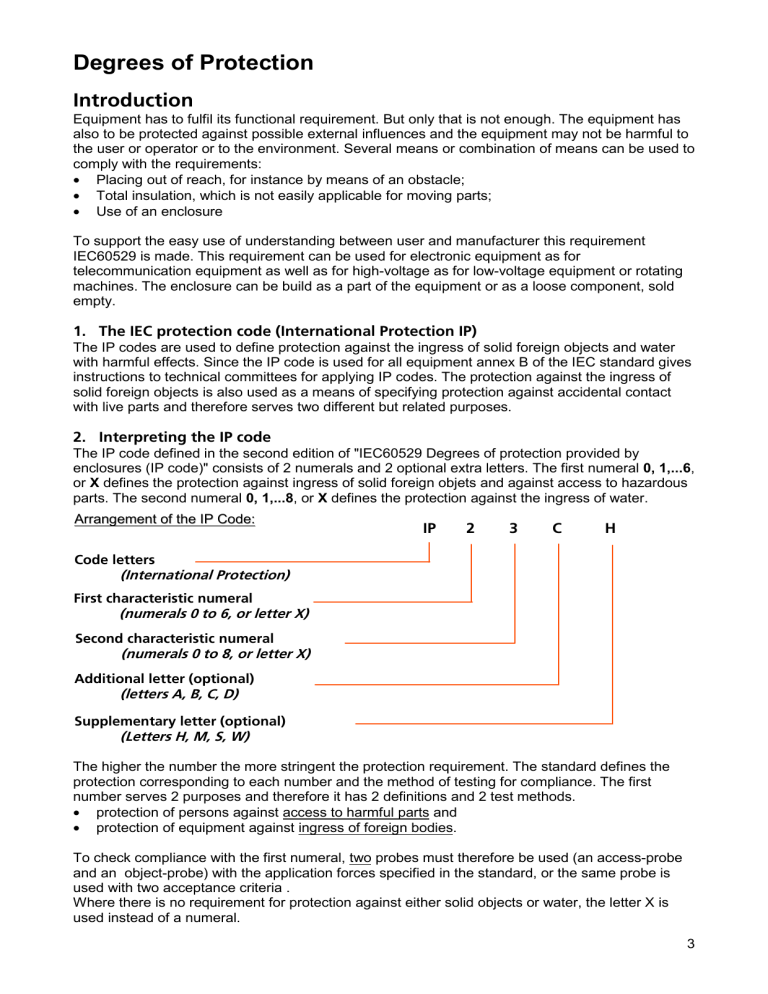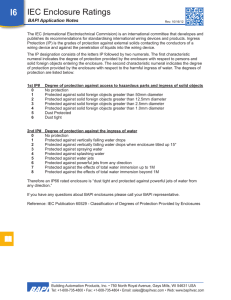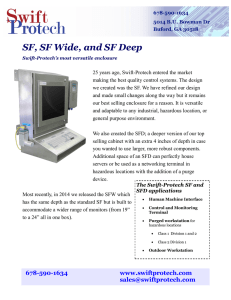
Degrees of Protection Introduction Equipment has to fulfil its functional requirement. But only that is not enough. The equipment has also to be protected against possible external influences and the equipment may not be harmful to the user or operator or to the environment. Several means or combination of means can be used to comply with the requirements: • Placing out of reach, for instance by means of an obstacle; • Total insulation, which is not easily applicable for moving parts; • Use of an enclosure To support the easy use of understanding between user and manufacturer this requirement IEC60529 is made. This requirement can be used for electronic equipment as for telecommunication equipment as well as for high-voltage as for low-voltage equipment or rotating machines. The enclosure can be build as a part of the equipment or as a loose component, sold empty. 1. The IEC protection code (International Protection IP) The IP codes are used to define protection against the ingress of solid foreign objects and water with harmful effects. Since the IP code is used for all equipment annex B of the IEC standard gives instructions to technical committees for applying IP codes. The protection against the ingress of solid foreign objects is also used as a means of specifying protection against accidental contact with live parts and therefore serves two different but related purposes. 2. Interpreting the IP code The IP code defined in the second edition of "IEC60529 Degrees of protection provided by enclosures (IP code)" consists of 2 numerals and 2 optional extra letters. The first numeral 0, 1,...6, or X defines the protection against ingress of solid foreign objets and against access to hazardous parts. The second numeral 0, 1,...8, or X defines the protection against the ingress of water. Arrangement of the IP Code: IP 2 3 C H Code letters (International Protection) First characteristic numeral (numerals 0 to 6, or letter X) Second characteristic numeral (numerals 0 to 8, or letter X) Additional letter (optional) (letters A, B, C, D) Supplementary letter (optional) (Letters H, M, S, W) The higher the number the more stringent the protection requirement. The standard defines the protection corresponding to each number and the method of testing for compliance. The first number serves 2 purposes and therefore it has 2 definitions and 2 test methods. • protection of persons against access to harmful parts and • protection of equipment against ingress of foreign bodies. To check compliance with the first numeral, two probes must therefore be used (an access-probe and an object-probe) with the application forces specified in the standard, or the same probe is used with two acceptance criteria . Where there is no requirement for protection against either solid objects or water, the letter X is used instead of a numeral. 3 An example of this is sub-clause 5.13.2 of "IEC60694 Common specifications for high-voltage switchgear and controlgear" which defines the second numeral as being X since no protection against ingress of water is specified. This is understandable for high-voltage indoor equipment which is normally installed in electrical rooms having controlled access. Specifying protection against the ingress of water should be done only if there is a real danger of much water falling on the equipment. The test requirement for numeral 1 calls for at least 10mm of water dripping on the enclosure during a 10 minute period. This is much more than just a bit of condensation. In general, for the first characteristic numeral, adequate clearance is sufficient. That means for lowvoltage equipment that the access probe shall not touch the hazardous parts. For high-voltage equipment it means that when the access probe is placed in the most unfavourable position it must be possible to withstand the dielectric test applicable to the equipment. For equipment with hazardous mechanical parts the access probe shall not touch hazardous mechanical parts. To pass the test for the first characteristic numerals 1, 2, 3, and 4 against solid foreign objects it is satisfactory if the full diameter of probe does not pass through any opening. To pass the test for the first characteristic number 5 it is satisfactory if talcum powder has not accumulated in a quantity or location such that it could interfere with correct operation of equipment or impair safety. To pass the test for the first characteristic number 6 it is satisfactory if no deposit of dust is observable inside the enclosure at the end of the test. To pass the test for the second characteristic numerals it is sufficient that in general, if any water has entered there are no harmful effects on operation, safety or insulating parts. To pass the test for the additional letter for protection against access of hazardous parts it is sufficient that adequate clearance is kept between the access probe and hazardous parts. 3. Optional letters Sub-clause 7 of IEC60529 allows the use of an additional letter A, B, C, or D to indicate protection of persons against access to hazardous parts. For example, such higher protection may be provided by barriers, suitable shape of openings or distances inside the enclosure. Additional letters are only used: • if the actual protection against access to hazardous parts is higher than indicated by the first characteristic numeral; • or if only the protection against access to hazardous parts is indicated, first numeral being then replaced by an “X”. An example of this is sub-clause 7.7 "IEC60439 Low-voltage switchgear and controlgear assemblies" which specifies the protection against contact with hazardous parts belonging to adjacent functional units as being at least IPXXB. Sub-clause 8 of IEC60529 allows the use of supplementary letters H, M, S, or W to indicate additional requirements generally associated with the ingress of water. As an example; sub-clause 5.13.2 of IEC60694 states that outdoor equipment should use the supplementary letter W rather than a second numeral (for example IP5XW) and gives the specific test procedure to be used. General rule with regard to IP Code: An enclosure shall only be designated with a stated degree of protection indicated by the IP Coding if the enclosure also complies with all lower degrees of protection. 4 4. Elements of the IP Code and their meanings: Element Code letters Numerals or letters IP First characteristic numeral X 0 1 2 3 4 5 6 Second characteristic numeral Meaning for the protection of equipment Meaning for the protection of persons - - Against ingress of solid foreign objects: Against access to hazardous parts with: not required (non-protected) ≥ 50 mm diameter ≥ 12,5 mm diameter ≥ 2,5 mm diameter ≥ 1,0 mm diameter dust-protected dust-tight not required (non-protected) back of hand finger tool wire wire wire Against ingress of water with harmful effects: X 0 1 2 3 4 5 6 7 8 not required (non-protected) vertically dripping dripping (15° tilted) spraying splashing jetting powerful jetting temporary immersion continuous immersion Additional letter: optional - Against access to hazardous parts with: A B C D Supplementary Letter: optional H M S W - Supplementary information specific to: High voltage apparatus Motion during water test Stationary during water test Weather conditions back of hand finger tool wire - 5 5. Examples of IP codes IP00 This code means that there is no protection at all. A typical example is a dry-type transformer without any enclosure. The transformer would be installed indoors in a bay having a door in order to prevent accidental contact with live parts. IPXXB This means protection against ingress of solid foreign objects and water is not required and access to hazardous parts is protected for incidental contact with fingers. IP2X This is the IP code necessary to prevent access to hazardous parts with fingers and protects the equipment inside the enclosure against ingress of solid foreign objects having a diameter of 12.5 mm and greater. IP3XD This is a typical IP code for high-voltage and low-voltage switchgear and controlgear located in electrical rooms and access to hazardous parts for protection of persons handling wires. IP53 This is the minimum IP code that should be used for equipment installed outdoors. IP54 would be a better choice since the second numeral 4 means protection against water coming from all directions whereas the numeral 3 means protection against water coming from an angle of 60°. Table with examples: IP0X IP1X IPXXB IP2X IP3X IP3XD IP4X IP5X IP6X DEGREE OF PROTECTION Protected Against Definition Non-protected Access to hazardous parts with the An access probe, sphere of 50 mm Ø, shall have back of a hand. adequate clearance from hazardous parts. Solid foreign objects of 50 mm Ø . An object probe, sphere of 50 mm Ø , shall not fully penetrate. Access to hazardous parts with finger. A jointed test finger of 12 mm Ø , 80 mm length, shall have adequate clearance from hazardous parts Solid foreign objects not required. Access to hazardous parts with finger. A jointed test finger of 12 mm Ø , 80 mm length, shall have adequate clearance from hazardous parts Solid foreign objects of 12.5 mm Ø . An object probe, sphere of 12.5 mm Ø , shall not fully penetrate. Access to hazardous parts with a tool. An access probe of 2.5 mm Ø shall have adequate clearance. Solid foreign objects of 2.5 mm Ø . An object probe of 2.5 mm Ø shall not penetrate at all. Access to hazardous parts with a wire. An access probe of 1 mm Ø shall have adequate clearance. Solid foreign objects of 2.5 mm Ø . An object probe of 2.5 mm Ø shall not penetrate at all. Access to hazardous parts with a wire. An access probe of 1.0 mm Ø shall have adequate clearance. Solid foreign objects of 1.0 mm Ø. An object probe of 1.0 mm Ø shall not penetrate at all. Access to hazardous parts with a wire. An access probe of 1.0 mm Ø shall have adequate clearance. Dust (protected). Ingress of dust is not totally prevented, but dust shall not penetrate in a sufficient quantity to interfere with satisfactory operation of the apparatus or to impair safety. Access to hazardous parts with a wire. An access probe of 1.0 mm Ø shall have adequate clearance. Dust (tight). No ingress of dust. 6 IPX0 IPX1 IPX2 IPX3 IPX4 IPX5 IPX6 IPX7 IPX8 DEGREE OF PROTECTION Protected Against Definition Non-protected. Vertically falling water drops. Vertically falling drops shall have no harmful effects. Vertically falling water drops when Vertically falling drops shall have no harmful effects enclosure tilted up to 15º. when the enclosure is tilted at any angle up to 15º on either side of the vertical. Spraying water. Water sprayed at an angle up to 60º on either side of the vertical shall have no harmful effects. Splashing water. Water splashed against the enclosure from any direction shall have no harmful effects. Water projected in jets against the enclosure from any Water jets. direction shall have no harmful effects. Powerful water jets. Water projected in powerful jets against the enclosure from any direction shall have no harmful effects. The effects of temporary immersion in Ingress of water in quantities causing harmful effects water. shall be prevented when the enclosure is immersed in 1m of water for 30 minutes. The effects of continuous immersion Ingress of water in quantities causing harmful effects in water. shall be prevented when the enclosure is continuously immersed in water under conditions which shall be agreed between manufacturer and user (>IPX7). Examples of designations with the IP Code: IP Code not using optional letters: IP 34 An enclosure with this designation (IP Code): (3) - protects persons, handling tools having a diameter of 2,5 mm and greater, against access to hazardous parts; - protects the equipment inside the enclosure against ingress of solid foreign objects having a diameter of 2,5 mm and greater; (4) - protects the equipment inside the enclosure against harmful effects due to water splashed against the enclosure from any direction. Examples of designations with the IP Code: IP Code using optional letters: IP 23 C S (2) - protects persons against access to hazardous parts with fingers; - protects the equipment inside the enclosure against ingress of solid foreign objects having a diameter of 12,5 mm and greater; (3) - protects the equipment inside the enclosure against harmful effects due to water sprayed against the enclosure; (C) - protects persons handling tools having a diameter of 2,5 mm and greater and a length not exceeding 100 mm against access to hazardous parts (the tool may penetrate the enclosure up to its full length); (S) - is tested for protection against harmful effects due to ingress of water when all the parts of the equipment are stationary. 7 6. Access probes for testing of persons against access to hazardous parts: Access probe: Sphere 50 mm diameter; test force 50N +/- 10% 4 ∅ 45 ∅ 10 Handle Sphere 50 +0,005 0 Guard (Insulating material) Rigid test sphere (Metal) Access probe: Jointed test finger; test force 10N +/- 10% Stop face ( ∅ 50 × 20 ) ∅ 12 Jointed test vinger (Metal) 80 Insulating material Access probe: Test rod 2,5mm diameter, 100mm long; test force 3N +/- 10% Approx. 100 Sphere 35 ± 0,2 100 ± 0,2 ∅ 10 Handle (Insulating material) Stop face (Insulating material) Rigid test rod, ∅ 2,5 + 0,05 0 (Metal) Edges free from burrs 8 Access probe: Test wire 1,0mm diameter, 100mm long; test force 1 N +/- 10% Approx. 100 Sphere 35 ± 0,2 100 ± 0,2 ∅ 10 Rigid test rod, ∅ 1 Handle (Insulating material) + 0,05 0 (Metal) Stop face (Insulating material) Edges free from burrs Object probes and test means for the test for protection against solid foreign objects Example of test for second characteristic numeral 1: Drip box Xiria installation under test 9 7. Test means for the tests for protection against solid foreign objects: First numeral Test means (object probes and dust chamber) Test force 0 No test required - 1 Rigid sphere without handle or guard (50mm diameter) Rigid sphere without handle or guard (12,5mm diameter) Rigid steel rod 2,5mm diameter with edges free from burrs Rigid steel wire 1mm diameter with edges free from burrs Dust chamber, with or without underpressure Dust chamber, with underpressure 50N ± 10% 2 3 4 5 6 30N ± 10% 3N ± 10% 1N ± 10% - 8. Test means and main test conditions for the test for protection against water Second numeral Test means Water flow rate Duration of test 0 No test required - - 1 2 Drip box Drip Box (Enclosure 15° tilted) 1 mm/min. 3 mm/min. 10 min. 10 min. 3 Oscillating tube: distance max. 200mm / Spray nozzle; Spray ±60° from vert. 10 l/min. 1 min/m2 (≥ 5 min) 4 As for 3; Spray ±180° from vert. “ “ 5 Water jet hoze nozzle 6,3mm; distance 2,5 to 3m 12,5 l/min. 1 min/m2 (≥ 3 min) 6 Water jet hoze nozzle 12,5mm; distance 2,5 to 3m 100 l/min. “ 7 Immersion tank; water-level on enclosure 0,15m above top, 1m above bottom - 30 min. 8 Immersion tank; water-level by agreement - by agreement 10 9. Examples of situations: IP Code: IP 0X Situation 1: Sphere 50 IP Code: IP 1X Situation 2: (1X + A = 1X) Sphere 50 IP Code: IP 1X Situation 3: (1X + A = 1X) ∅ 12 Sphere 12,5 IP Code: IP 1XB Situation 4: (1X + B = 1XB) ∅ 12 ∅ 30 11 IP Code: IP 2XC Situation 5: ∅ 1,0 (2X + C = 1XC) ∅ 2,5 IP Code: IP 2XD Situation 6: (2X + D = 2XD) ∅ 2,5 ∅ 1,0 IP Code: IP 4X Situation 7: (4X + D = 4XD) ∅ 1,0 IP Code: IP 1XD Situation 8: Sphere 35 (1X + D = 1XD) > 12,5 < 20 ∅1 100 12 IP Code: IP 1XB Situation 9: (1X + B = 1XB) Sphere 12,5 15 IP Code: IP 2X Situation 10: (2X + B = 2X) Sphere 12,5 1 2 ,3 IP Code: IP 3XD Situation 11: (3X + D = 3XD) ∅ 1,0 2 10. Conclusion: • • In general: for protection against direct contact with hazardous parts IP 2X or IP XXB is required In Holec products MMS, Unitole en Xiria installations the protection of persons against access to hazardous parts is IP 3XD and for SVS IP2XD. 11. References: ‘IEC60529 Second edition 1989-11 + Am. 1 1999-11, EN60529’, Degrees of protection provided by enclosures’ by CEI. ‘Degrees of protection provided by enclosures (IP codes)’ M-124’, Course (Syria - Damascus) 21 May 2002, Mr M. Leusenkamp, Holec, The Netherlands. ‘Enclosures and degrees of protection’ , Çahier Technique N˚. 166 first issued January 1993, Mr. Jean Pasteau, Schneider Electric. 13


